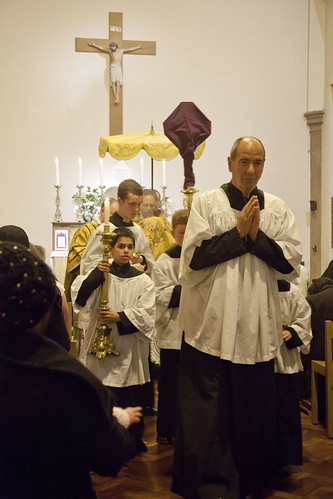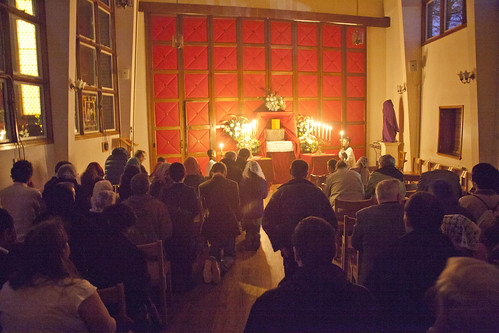 |
| Taking the Blessed Sacrament to the Altar of Repose on Maundy Thursday. |
---------------------------------------
Austen Ivereigh claims that in opening the Mandatum to women, Pope Francis is 'restoring an older Tradition'. Claiming the change has 'infuritated traditionalists' (sorry, Austen, I'm not infuriated), he explains:
Yet Francis has been restoring what once was tradition. The custom in the seventeenth century, for example, was for bishops to wash, dry and kiss the feet of 13 poor people after having dressed them and fed them. Nor is there any obligation for the foot-washing to be part of the Mass of the Lord’s Supper.
This is a bit thin as an explanation, so let me fill it in a bit. Because Ivereigh has a point.
It is the rubrics of 1955 and 1970 which say that the foot-washing of Maundy Thursday should happen (a) after the Gospel, (b) in the choir or sanctuary of the church, and (c) to 'viri', men as opposed to women.
N.b. the word 'viri' (plural of 'vir') is only used if you want to exclude women. There is another Latin word for 'men' in the sense of 'people': 'homines' (plural of 'homo'); again, you might expect the gender neutral 'christifideles' (the Faithful) or some such term to be used, if gender was not an issue.
Before 1955, and in accordance with an organically developing tradition going back to the earliest times, the Mandatum took place (a) after Mass was over, after the 'stripping of the Altars' ceremony, (b) not in the sanctuary, and (c) to 'pauperes': the poor. Also, interestingly, as as Ivereigh notes, the number of pauperes was 13, not 12. Indeed, the Mandatum carried out in the context of a parish celebration of the Mass of Maundy Thursday, by a parish priest, was simply a particular case of a wider phenomenon, of Maundy Thursday foot-washing by bishops, abbots, abbesses, kings and queens, lords and ladies, of poor folk. Rubricarius (who knows about these things) tells us in my com-box that the Parish Priest, in line with the wider phenomenon, would have been expected to give these pauperes food, clothing, and money afterwards.
Male foot-washers would have washed male feet, and female washers female feet, as a matter of pudicy. If Ivereigh thinks that a 17th century bishop would have washed the feet of women, he's wrong. (I love the way he implies they did, without quite implying that they did.) Such considerations of pudicy are still relevant in our multi-cultural world: yes, multi-culturalism can mean taking care not to offend people with more old-fashioned attitudes that your own, such as those of American gangsters (bad language warning). What that famous scene from Pulp Fiction demonstrates is that a man touching a woman's feet has an erotic meaning.
I really wouldn't want any priests to 'develop a speech impediment' as a result of washing ladies' feet.
What happened in 1955 was that the Mandatum was made a liturgical act, in the middle of Mass and in the sanctuary, in the form of a literal-minded re-enactment of the scene described in the Gospel of St John (13:1-17). As has often been pointed out, Our Lord washed the feet of His Apostles, His priests: but that is not how it has been understood and imitated in the Latin liturgical tradition. Rather, the command has been understood in a more general sense that the higher should serve the lower, whether the higher is religious or secular, whether the relationship is sacramental or economic. Indeed, one can see in the tradition an application of a specifically lay obligation, to conform secular relationships to the reign of Christ.
As for the 1955 rite, it goes along with a current of thought which understands the liturgy as re-enactment in a way it had never been understood before, a form of antiquarianism. The argument that the 'original meaning' or 'original form' of something should be restored, often on the basis of bad scholarship or simple fantasy, was heard even more loudly in 1970 than in 1955. Along with supposedly authentic vestments and pottery chalices, we have a 'restored' kiss of peace, 'restored' bidding prayers, and a 'restored' offertory procession, and it is common to hear people unable to understand why the priest does not break the Host while saying the words 'He broke the bread', and why the Feast of the Holy Innocents is celebrated before Epiphany, when the event it commemorates took place after. In every case the wisdom of the developed tradition is lost, along with the continuity of what we do with what our immediate predecessors did - usually for at least the last eight centuries, and often for a lot longer.
I said in my last post that the latest change to the Mandatum reflects the results of the contradictions of the 1970 Missal. I should make clear that in this case, the contradiction was inherited from the 1955 reform of Holy Week, for which I have no brief to defend. The contradiction consists specifically in the way the rite uses the sanctuary. The sanctuary is a space for the clergy and their assistants, and the nave is the space for the Faithful. The distinction between the sanctuary and the nave is similar to the distinction marked by the use of Latin, marking out sacred time and space. It is just inappropriate for a dozen lay men to troop into the sanctuary, wearing ordinary clothes, and start taking off their shoes and socks. Adding lay women to the mix doesn't help. The result of the conflict between seeing the sanctuary as a sacred space, and seeing it as a handy 'performance space' for all sorts of activities, results in the disappearance of the former idea. The placing of the Mandatum there wasn't the decisive move, but it was part of a problematic trend.
 |
| Maundy Thursday with the FSSP in Reading: the Altar of Repose. |
For the problems of the 1955 Holy Week Reform, see the Position Papers on that, Part I and Part II.
Support the work of the LMS by becoming an 'Anniversary Supporter'.
This is very helpful, thank you. As I understand it, our Holy Week liturgy grew out of the ceremonies at Jerusalem in the early years of the Church, which included some historical re-enactment - the procession on Palm Sunday is another survival of that, even though the liturgy generally does not operate in that way.
ReplyDeleteGiven this wider way of understanding the mandatum and given that the ritual has now become an established element of Holy Week, the question could be, Is there any real objection to incorporating a more inclusive mandatum in the liturgy of Maundy Thursday, where it is obviously appropriate? And if the action of washing feet in imitation of Our Lord is a sacred action, as it surely is, why should one object to it taking place in a sacred space? Can these distinctions not become too rigid and so lose their point? Also I hope there are not many priests likely to develop a speech impediment through touching women's feet. Most of the priests I know, I'm glad to say, are not so precious or squeamish.
By the way the OED does not have recognise 'pudicy.' It does have pudency and the French pudeur used in English.
You've clearly not watched 'Pulp Fiction'. The guy develops a speech impediment as a consequence of being thrown out of a fourth-story window onto a conservatory, by the outraged husband.
ReplyDeleteHey, this is Tarantino! :-)
As the post indicates, a liturgical instinct would see it as unfitting to have the ceremony in the sanctuary, and a traditional moral instinct would see it as unfitting for a priest to wash the feet of women. These are arguments of overwhelming force, given the nature of the liturgy, above all in the Sacred Triduum. But if you don't see that, I can't force you.
ReplyDeleteEvidence of the instinct involved would include the 1974 GIRM forbidding women to go into the sanctuary.
I see the OED gives 'pudic', 'pudical' and 'pudicality'; 'pudicy' is a natural enough extension. See also
http://www.lmschairman.org/2015/01/modesty-and-pudicy.html
Some would say, and I find the argument one of overwhelming force, that if God is in all things (as we must surely believe he is), there is no such thing as a "sacred" realm distinct from the secular, but strictly speaking everything is sacred. It is only our human projection onto God that makes us analyse, divide and categorise. But if you don't see that, I can't force you.
DeleteNo, I haven't seen 'Pulp Fiction,' but I doubt if it has much to say about clerical psychology.
P.S. i don't really mind if you want to neologise. Ordinary English is good enough for me, in the Mass as elsewhere. It is after all just as "sacred" a language as Latin.
DeleteYou must realise that your view is incompatible with the way God has revealed Himself in both Testaments of Scripture. The burning bush? The Temple?
DeleteWhat is incompatible with what? God reveals himself in many ways, in creation, in history, in scripture. He is surely not limited to the realms in which we prefer to confine him.
DeleteA thought: is there anything to stop an old rite Mandatum being "celebrated" after the Ordinary form of Holy Thursday evening Mass?
ReplyDeleteA thought: is there anything to stop an old rite Mandatum being "celebrated" after the Ordinary form of Holy Thursday evening Mass?
ReplyDeleteNothing at all.
Delete'Pudicity' seems OK.
ReplyDeleteI would like to attend a Holy Week liturgy done prior to 1955, to see what it was like. Would a SSPX chapel do it?
ReplyDeleteThe SSPX are very strict in only following the books of 1962.
DeleteThank you for your excellent posts on this topic.
ReplyDeleteI do find it interesting that a Rite made up in 1955 is now seen as being partially mistaken, and wonder if we will see other mistakes admitted and corrected.
The Position Paper gives a whole list of aspects of the 1955 reform which were recognised as mistakes and reversed in 1970, notably the reduction of the number of readings from 12 to 4 in the Easter Vigil.
Delete“It should be emphasised that the Mandatum (and the time of day it is celebrated) are the only changes to the ancient Mass of Maundy Thursday made in 1955.”
ReplyDeleteUnfortunately, that is not correct. In the new, 1956, rite (i) the tabernacle is empty to begin with; (ii) the Introit is chanted as the procession leaves the sacristy; (iii) the Creed is omitted; (iv) the third petition of Agnus Dei is miserere nobis; (v) the prayer Domine, Jesu Christi omitted; (vi) the Confiteor and absolution before Communion is suppressed for the first time, later of course abrogated in the 1962MR throughout the whole year except for Good Friday: (vii) Benedicamus Domino replaces Ite, missa est: (viii) the blessing is omitted; and, (ix) the last Gospel omitted.
In the middle ages, there were instances of a king washing feet of poor men, and the queen doing this to poor women (outside Mass, of course).
ReplyDeleteBut according to this author, the washing of feet of faithful of both sexes by bishop was practiced in early Church (IV-V cent.), although it is not clear to me from the citations he gives:
http://athanasiuscm.org/2016/01/21/the-god-of-surprises-vs-the-tradition-on-feet-washing/
One also sees there a very diverse and confusing theological explanations of this rite by Fathers.
He doesn't quote an explicit reference to men washing women. My take is that it that it would have been unthinkable, but I'm willing to be persuaded. I've left a comment there.
ReplyDeleteI thought Pius XII only changed the times of the services? That was Michael Davies' view.
ReplyDelete